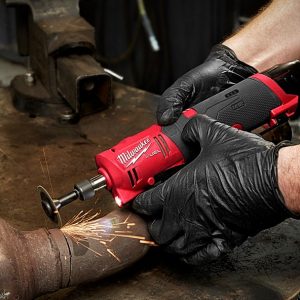
Die Grinder Vs Angle Grinder! Now, both these tools fall under the category of rotary tools. Each unique project requires a specific set of tools to achieve the required result, and that’s where this article comes in handy.
We’ll discuss the two most prominent grinders in the market these days so that you can pick the perfect tool for your project.
Die Grinder

A power hand-held tool that can be used for almost everything that an angle grinder does. Though, these tools are used for projects that require more precision and less power. It’s a famous tool that has found its way around a lot of tool-boxes. It’s available in three varieties; corded electric, wireless electric and pneumatic.
Angle Grinder

Angle grinders are heavy tools used for various projects, either in your garage or on a construction site. They are called angle grinders since their cutting head is positioned on a given angle to the drive shaft. They have various attachments which allow them a multitude of uses such as; cutting, grinding, dimensioning tiles, sharpening tools, grinding mortar, polishing aluminum, sanding and smoothing all sorts of materials. Over the years, angle grinders have been developed to suit your needs, and now there are four types available; corded, wireless, pneumatic, and fuel-powered. You can also check: How to Use an Angle Grinder Tool
Common Specs
Most of the uses are common but on different scales. They can both do polishing, sharpening, grinding, and cutting of different materials. Also, they both boast a wide range of attachments, which allows for such variation.
Both tools require hefty safety measures to be taken as they create a lot of aerial debris, which poses a particular hazard for your eyes. If you buy either, don’t forget a good pair of goggles and, because your hands are at risk, a pair of gloves.
Lastly, they’re both rotary tools, meaning that the speed of the rotating discs/attachments is what’s carrying out the job.
Differences
Both the tool and the disc are a lot larger in an angle grinder than the die grinder, therefore, angle grinders are heavier. An average die grinder weight ranges from 6+ pounds while angle grinder ranges from 11 lbs.
Lightweight and smaller discs allow for higher speed; therefore, die grinders have a faster RPM with an average of 21,000 RPM, whereas angle grinders make an average of 11,000RPM.
The larger frame of an angle grinder allows for a 1.8 horse-power motor while the smaller frame of the die grinder can only support a 0.25 powerhorse motor.
Another repercussion of the difference of sizes is that you can’t use one’s discs/attachments for the other as they vary greatly. Angle grinder discs sizes are bigger compared to die grinders. 4½ inch – 115mm is the most common angle grinder disc size, while the die grinder discs usually range from 2 to 3 inches.
With angle grinders, the projects usually involve a lot of grinding and cutting. There are, of course, other discs available for sanding, polishing, etc….
Although each one of these grinders has more than one subtype, there’s always a prevalent variety that is more commonly used: the pneumatic/air-powered die grinder and the electric angle grinder. Various types of die grinders might need different amounts of cubic feet of air per meter (CFM).
Although angle grinders make bigger cuts and work larger surfaces, a die grinder will always give you a more precise cut. Depending on the size of the die grinder, you might be able to get it into a tight space. Angle grinders are better suited for jobs where there is some room to operate.
How to Choose
Both tools are quite handy, and you won’t regret owning either of them. Yet, the determining factor here is the project before you and the kind of work you need to do. If your job needs precision and involves a lot of details such as handling small pieces that require small cuts or even wood crafting, then a die grinder is undoubtedly more suited for you.
Also, if you are working with limited space around you. While if you are working in a construction site, then the angle grinder will be your best friend. Working with large pieces of metal or wood, and needing a lot of power, then it is undoubtedly a job for an angle grinder. You can also check: How to Use an Angle Grinder Tool
Final Thoughts
Between the two, there’s no way to determine which of them would be the better overall. In a nutshell, a die grinder’s tiny nose allows you to make fine details and etches, while an angle grinder’s larger blade makes it better suited for larger projects.
As mentioned before, investing in both will not do you bad.